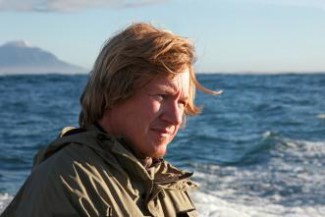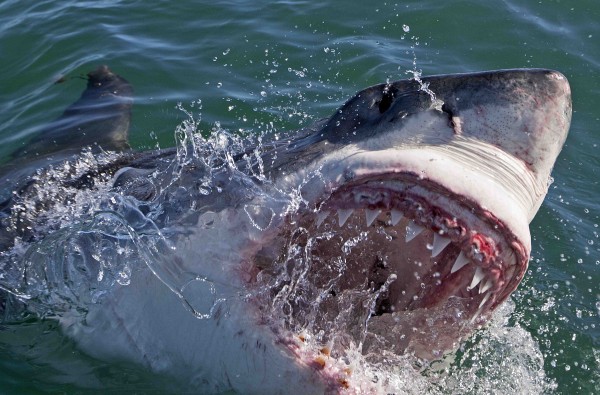INTERVIEW: Filmmaker searches for Colossus great white on Shark Week special

Shark Week returns to Discovery Channel Sunday, Aug. 10, and this year plans to be the year of Colossus. The opening night special is Air Jaws: Fin of Fury, a one-hour documentary that follows a team of filmmakers as they hunt down a legendary great white shark known as Colossus off the coast of South Africa. Jeff Kurr, the man behind the camera of the Air Jaws franchise, first saw Colossus three years ago, and now he’s back to find the elusive great white.
“I’ve actually been involved with Shark Week since 1991 when it was in its infancy, and so I just at that time became really interested and intrigued by sharks,” Kurr said recently during a phone interview. “It just grew and grew every year. It’s become more and more popular every year, and here I am I guess 24 years later still with a lot of interest in sharks and passion to learn more about them and to bring back footage that no one’s ever seen before.”
The Air Jaws franchise, which is an annual fan favorite of Shark Week, is believed to be the first program to “showcase the flying great white sharks of Seal Island in South Africa,” Kurr said. The apex-predator spectacle is something awe-inspiring. The gigantic sharks blast out of the water, sometimes 20 feet into the air, to attack and kill their seal prey. Air Jaws first found the sharks in 2001; these more recent incarnations are semi-sequels.
“It’s gosh the fifth or sixth episode of Air Jaws, and in this particular episode it focuses on my attempts along with my colleague Chris Fallows to find a certain great white shark that we’re rather fond of named Colossus. I first met Colossus back in 2011 when we were filming Air Jaws: Apocalypse. It was a great white shark that was really interested in us and really interested in our boat when we were working at Seal Island. In fact, there’s sort of a famous photograph of me being towed in a little metal craft called a seal slip behind the boat right through the area where the white sharks hunt. And my objective was to get a really close-up low-angle shot of a great white shark flying out the water, sort of from the seal’s perspective. What ended up happening was I was being towed through that area we call the ‘ring of death’ for about 90 minutes, and this giant shark came flying out of the water right over the top of me, probably 3,000 pounds, maybe roughly 15 feet long. Splashed down, soaked me, an unbelievable shot. And it turned out that shark was Colossus, and I was kind of predicting it was Colossus because he took such an interest in us.”

After the amazing breach — one that would scare the average marine tourist — Colossus disappeared. The filmmakers were unsure why he would leave Seal Island, an island plentiful with prey. This year, Kurr and company made it their mission to find Colossus again.
“It was just an incredible journey into the world of the great white shark unlike anything anyone has ever seen,” he said of the finished product. “At times it was really scary because we were doing some things that people had never tried before with great white sharks, but it was an incredible look at these animals both underwater and above the water.”
Kurr said Fin of Fury was two years in the making with most of the filming taking place in the lucrative months of June and July. During the North American summer (South African winter), the sharks are doing the most hunting. All told, Kurr said the crew filmed on the sea for 30-40 days.
“I often ask myself why I’m attracted to the great white shark as opposed to all the other 370-odd species of shark, and I think that question is answered the moment I get in the water with them,” he said. “They’re just so spectacular. From a size perspective, they’re so huge, and I see an intelligence in these animals, a curiosity in these animals that have been regarded as mindless killing machines. They’re actually very, very smart. Think about how smart a great white has to be to be able to outsmart and catch a seal, and we all know how smart seals are.”
As far as why the great whites breach the surface so much off the coast of South Africa, Kurr was uncertain, but he had a few guesses. The first possibility is prey. There are roughly 60,000 seals living on Seal Island, and up to 40 sharks that circle the habitat. Those are some decent odds to grab food. However, these sharks are fiercely competitive, which may drive their high-speed aerial attacks.
“It’s almost like watching a Polaris missile because the sharks sometimes shoot straight up out of the water, and you know they’re coming from pretty deep water in order to get that speed. And the deep water is another factor that contributes to them flying out the water there because right around Seal Island there’s drop-offs. The sharks basically cruise along the bottom in maybe 60-70 feet of water and look up and see these seals on the surface, and then just rocket up to the surface. So the deep water gives them time to build up the speed they need to come flying out of the water.”
Other than the depth and competition, most of the breaches are a mystery. A shark will sometimes surface near Seal Island, swim 50 miles away and never come up.
Because of the success of Air Jaws and news stories about South Africa’s unique coastline, the word is out among tourists. This has caused a different scene on the waters. In 2001, when Kurr first visited Seal Island, his was the only boat in the water. Today, during the peak time of seeing the breaches, there are other boats packed with tourists. They are “all looking at this spectacle, which is really one of the greatest spectacles in nature where you can actually see an apex predator hunting down and killing its prey with regularity. I mean you can see up to 25 to 30 of these predatory events every single day. So it’s become hugely popular and actually great PR for the sharks because people from around the world go to South Africa now to see these Air Jaws sharks, and when they come home, they are changed people, the people I’ve talked to.”
Kurr said this P.R. for the sharks is good because not everyone is focused on appreciating the wildlife. Because of commercial overfishing and the shark fin trade, sharks are in trouble. “This is a place where people can go down and see sharks in their natural environment,” he said. “It’s right near a major metropolitan area of Cape Town, so it’s easy to get to. And they can just enjoy the sharks really in their realm.”
One might even bump into Kurr’s boat while facing the choppy waters surrounding Seal Island.
By John Soltes / Publisher / John@HollywoodSoapbox.com
-
Shark Week’s Air Jaws: Fin of Fury premieres 8 p.m. Sunday, Aug. 10 on Discovery Channel. Click here for more information.


Would love to find out if someone finds this shark sharks or very interesting to me. Every since I read the book by Peter Benchley jaws I have been interested in shark! A replay would be nice. Happy shark finding! Thank you !